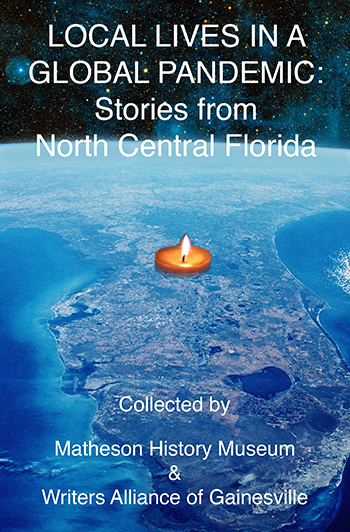Non-Fiction
Local Lives In A Global Pandemic: Stories from North Central Florida
Edited by Pat Caren, Charles Cobb, Ronnie Lovler & Mallory M. O’Connor
Cover art by John A. O’Connor
See Review by Seth Johnson, Mainstreet Daily News, Dec 16, 2021

“Not one of us was prepared for the tectonic shift to our daily lives that the COVID-19 pandemic would bring. We were suddenly and without grace forced into a new lifestyle uncontemplated and certainly unrehearsed.”
– Lauren Poe, Mayor, City of Gainesville, Florida
“Although not much can be considered ‘golden’ about the COVID-19 pandemic, it has presented us with an opportunity to tell a story of worldwide proportions, seen through the eyes of those in our own Alachua County community as it happens, day by day.”
– Dixie Nielson, Former Director, The Matheson Museum
“Finally, we thank the many contributors represented in the pages that follow. They have given voice and image to one of the more devastating global events to have occurred in our lifetimes. Their experiences and insights reflect the strong sense of community that characterizes the Gainesville area and which we trust will lead us out of this crisis.”
– The Editorial team
Florida’s American Heritage River: Images from the St. Johns Region
by Mallory M. O’Connor

A visual journey, through time, along the St. Johns River
“Indispensable for anyone seeking to explore Florida beyond the brochures.”–Herbert L. Hiller, author of Highway A1A: Florida at the Edge
“If you are looking for an elegant way to navigate up the St. Johns River without leaving your armchair, allow me to recommend spending time with this book. It is beautifully illustrated and a wonderful read.”–John Delaney, president, University of North Florida
The mighty St. Johns River flows from its headwaters near Lake Okeechobee north through central Florida to Jacksonville. Its watershed covers an area nearly the size of New Hampshire. The river and its tributaries have been part of the cultural landscape of the peninsula for thousands of years. From the Native Americans who first settled along its banks to the French, Spanish, British, and American settlers who followed, it has been a source of food, water, transportation, industry, agriculture, and recreation.
In 1998 the St. Johns was declared an American Heritage River, the only one in Florida and one of only fourteen in the country to be so designated. Shortly thereafter, Mallory O’Connor and Gary Monroe began searching for and collecting paintings, sketches, sculptures, photographs, and material culture from the region.
Searching in antique shops and art galleries, nineteenth-century periodicals and twentieth-century fish camps, the authors found literally thousands of images. They selected the best two hundred for this volume, some from the fine art tradition as represented by Thomas Moran and Martin Johnson Heade; others by self-taught visionaries. The result is a broad survey that captures and celebrates the beauty, power, and impact of this unique landscape.
Lost Cities of the Ancient Southeast
by Mallory M. O’Connor

When Columbus arrived on the shores of Hispaniola, a rich and complex civilization already existed that forms the core of American cultural history. Exploring ancient southeastern Indian sites from the metropolis of Cahokia (near present-day St. Louis), ancient capital of the American heartland, to the island stronghold of Calos, king of the Florida Calusa, Mallory O’Connor examines the significance of these prehistoric cultures.
Bringing together scholarship from classics in architecture, archaeology, and iconography, she discusses twenty sites of Mississippian culture, describing the religious patterns of the inhabitants and the sophisticated art works that supported their sacred practices. She also addresses the controversial topic of repatriation of Indian artifacts and the continuing problem of archaeological “looting” of Indian sites and ceremonial centers.
Lavishly illustrated with maps, site plans, and photographs of the ruins of ancient ceremonial centers along with sculpture, ceramics, and other artifacts, Lost Cities of the Ancient Southeast captures the timeless beauty and technical sophistication of the art and architecture of pre-Columbian America.
Mallory McCane O’Connor is director of the Santa Fe Gallery, Santa Fe Community College, in Gainesville, Florida. She has taught art history at the University of Florida and has published articles on art history and on gender and art in Native North American Art History, American Indian Art Magazine, and Southern Quarterly.
Barbara Gibbs, a Gainesville-based photographer, served as a photographic consultant for the Amazonia Research Institute, Brazil, and has photographed sacred ceremonial sites in Latin America and the American Southwest. She has exhibited her photographs in California and Florida.
